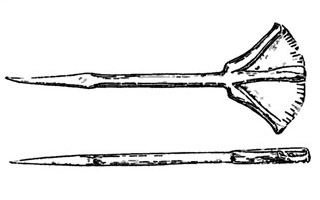In a list of Archaeological Acquisitions by the National Museum of Ireland in the year 1965; compiled by A. T. Lucas and published in the Journal of the Royal Society of Antiquaries of Ireland, volume 98, (1968), page 153 is what is suggested might be a Harp–key. With an acquisition number of 371 the description is given as;—

image drawn from the National Museum of Ireland Archaeological Acquisitions in the Year 1965
Harp–key (?). bronze. From a crannog at Loughnaglack. Drummond Otra td. Co. Monaghan. Shaft is circular in cross section with a long point of square cross–section. Splayed fan–like head, ornamented with radial grooves along the wide edge. L. 16.5 cm; W. of head. 3.9 cm; D. of shaft. 5mm. and there is also a drawing of the item as figure 12.
It has to be assumed that whoever raised the possibility of this item being a harp key was somewhat unfamiliar with harps and keys as there is little likelihood that this could have been used to turn a tuning pin. The opposite end to the broad head comes down to a rather sharp point and is clearly designed for piercing, although probably not in the more usual twisting motion of a conventional ‘awl’.
This device was perhaps designed for making holes in leather prior to lacing sections together or may have been a medieval scribe’s tool used for pricking and lining velum. This was the technique which, through its use for marking velum prior to drawing a musical stave, led to the term ‘to prick music’ meaning the act of writing down music. This in turn developed into ‘prick song’ meaning the use of written music.
Submitted by Keith Sanger, 6 January 2012
Except where otherwise noted, content on this site is licensed under a Creative Commons License.
Permissions beyond the scope of this license may be available by contacting us at editor@wirestrungharp.com.
